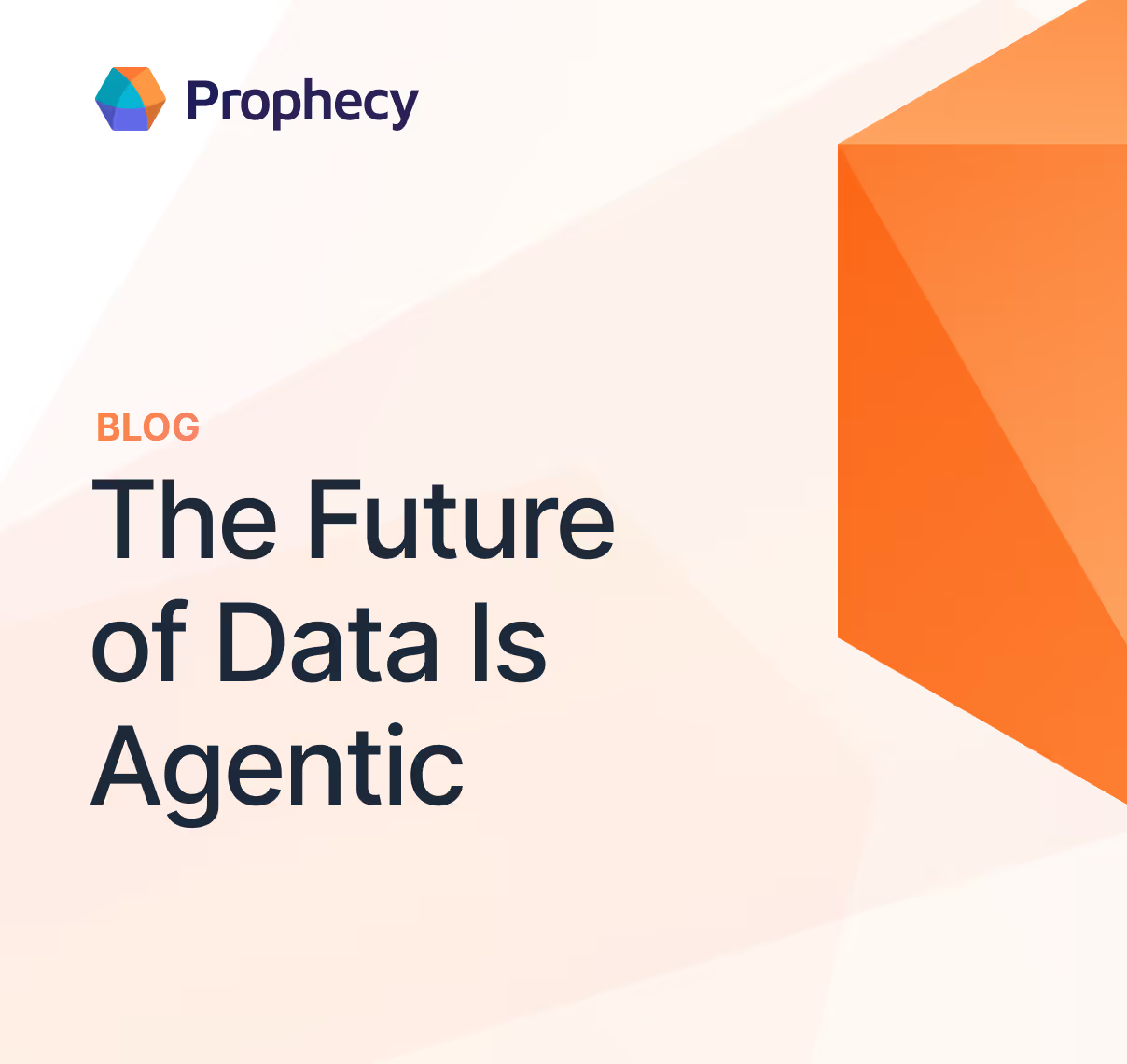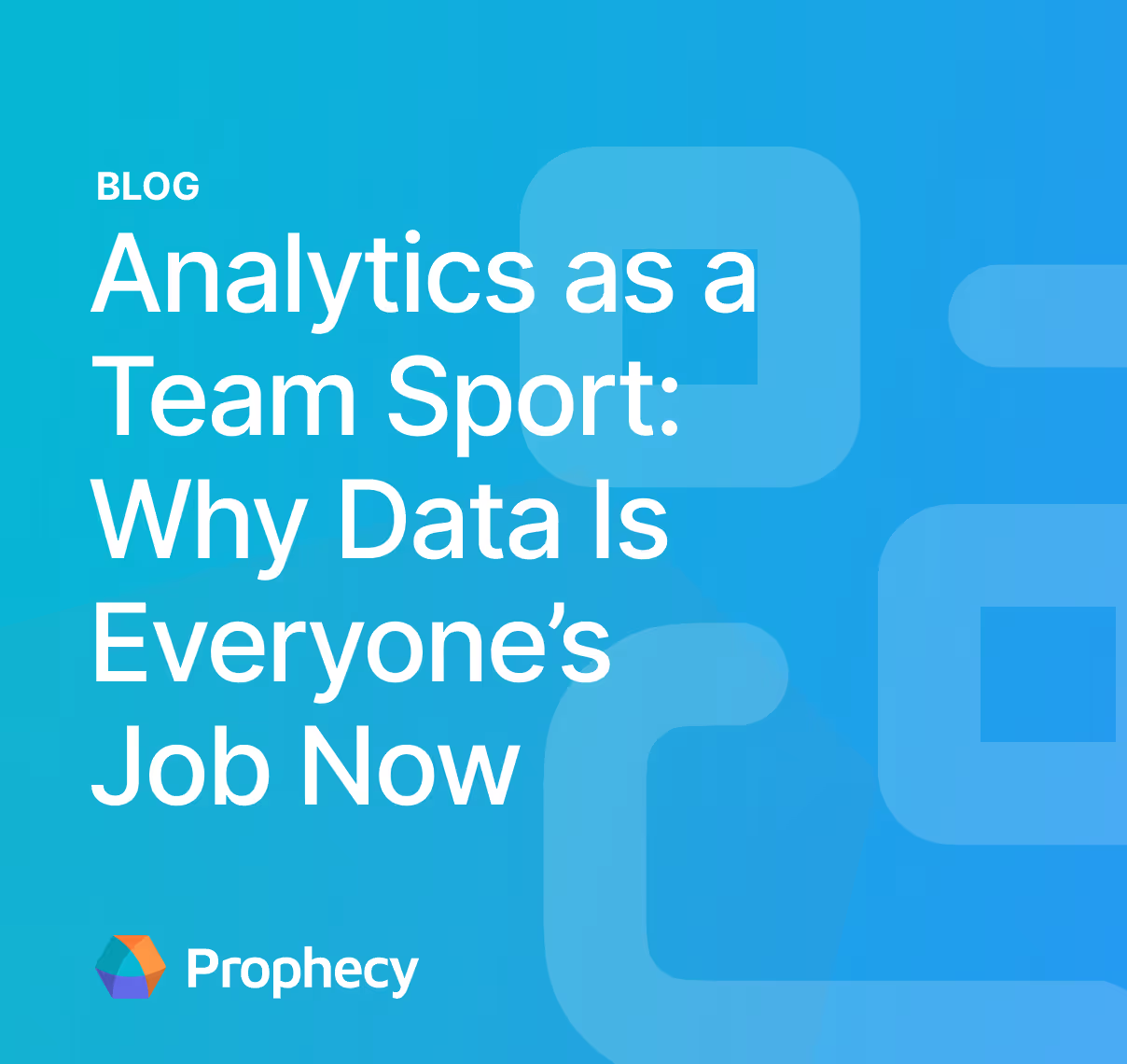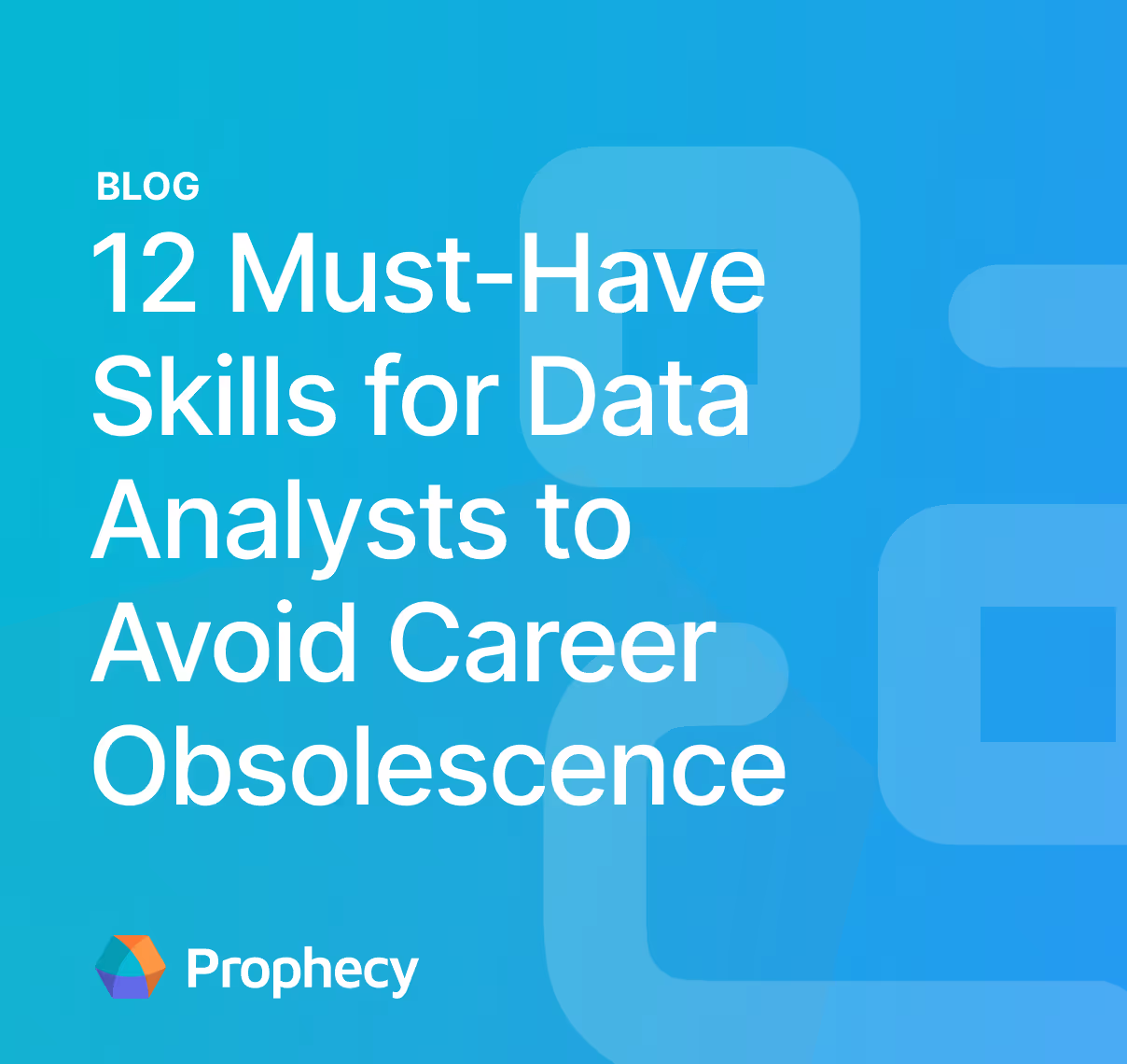Why Every Modern Enterprise Needs AI-Native Analytics
Discover AI-native analytics and how it enables enhanced decision-making, real-time insights, improved efficiency, and competitive advantage.
Remember when your biggest analytics question was "what happened last quarter?" Those days are quickly becoming ancient history.
Today's organizations are making a fundamental shift from reactive reporting to proactive decision-making, asking instead: "What should we do next?"
This evolution didn't happen overnight. Analytics has matured through distinct phases—from basic descriptive reporting that told us what occurred, to predictive models that forecasted what might happen, to prescriptive analytics that recommended specific actions. Each step forward has made data more valuable and actionable for businesses.
Now we're entering the next evolutionary leap: AI-native analytics. This represents a complete reimagining of how organizations interact with their data, going far beyond incremental improvements.
If you're still relying on traditional business intelligence tools, you're about to discover why that approach might be holding your organization back.
What is AI-native analytics?
AI-native analytics represents a new category of data platforms where artificial intelligence serves as the fundamental architecture rather than an add-on feature. These systems are built from the ground up with AI as their core operating principle. Every component, from data ingestion to insight delivery, is powered by machine learning and intelligent automation.
Some of the key components of an AI-native analytics platform include:
- Natural language queries: Natural language queries allow you to ask your data questions in plain English instead of wrestling with complex SQL syntax. Want to know which customers are most likely to churn next month? Just ask, and the system translates your question into the right technical commands behind the scenes.
- Smart discovery and prep: AI-native analytics platforms can automatically scan your data landscape to find relevant datasets and identify quality issues before they become problems. It's like having a data detective that never sleeps, constantly mapping connections and flagging inconsistencies you might miss.
- Pattern recognition: Some AI-native systems can learn to spot anomalies and trends that would take human analysts weeks to uncover. Whether it's detecting fraud, identifying seasonal patterns, or catching data drift, the AI works 24/7 to surface insights you didn't even know to look for.
- Self-healing pipelines: When something breaks or performance drops, the platform alerts you and fixes common issues automatically. Your data pipelines adapt to changing conditions, reroute around bottlenecks, and optimize themselves for better performance.
- Predictive intelligence: Beyond just telling you what happened, predictive analytics forecasts what's likely to happen next and suggests specific actions to take. You get both the "what if" scenarios and the "here's what you should do about it" recommendations.
- Continuous learning: Every interaction you have with an AI-native analytics platform makes it smarter for everyone on your team. The more you use it, the better it gets at understanding your specific business context and data patterns.
How does AI-native analytics compare to AI-enhanced and traditional analytics?
Understanding where different analytics approaches fit on the spectrum helps clarify why AI-native represents such a significant leap forward:
Traditional analytics
Traditional analytics relies on manual processes throughout the data lifecycle, which are slower and often lead to bottlenecks in the end-to-end analytics process. Consequently, business users end up working with information that's often days or weeks old by the time they receive it. For some analytics needs, that’s okay (not everything has to be real-time!), but most organizations have a number of critical asks better served by fresher data.
AI-enhanced analytics
AI-enhanced analytics takes those traditional workflows and adds AI features on top. You might get automated data profiling during preparation, some predictive models in your analysis, or anomaly detection in your dashboards. While these additions provide value and typically lead to more efficiency than you’d see in a traditional analytics model, they feel like separate capabilities bolted onto an otherwise manual process.
AI-native analytics
AI-native analytics flips the script entirely. Here, artificial intelligence forms the foundation rather than serving as just another feature. Every aspect of the platform, from data ingestion to insight delivery, is powered by AI. The system thinks, learns, and adapts continuously. Manual tasks can be replaced or, at the very least, made substantially more efficient. Instead of you working for your analytics tools, they work for you, anticipating your needs and proactively surfacing insights that drive action. The end-to-end process becomes much more efficient.
Why does your organization need AI-native analytics?
The business case for AI-native analytics isn't just compelling—it's becoming essential for competitive survival. Organizations that embrace this approach are gaining significant advantages across multiple dimensions of their operations:
Enhanced decision-making
Your business generates massive amounts of complex data daily. This creates patterns and correlations that human analysts simply cannot process fast enough or comprehensively enough to catch. AI-native analytics excel at this computational challenge, simultaneously analyzing thousands of variables to reveal hidden insights across your entire business ecosystem. Consequently, decision-making becomes more informed and objective, freed from human bias and cognitive limitations.
Real-time insights
Traditional analytics tell you what happened last week or last month. By then, opportunities have passed, and problems have compounded. AI-native solutions flip this paradigm entirely by continuously monitoring your operations and instantly detecting changes as they occur. Whether it's shifting customer behavior, emerging operational disruptions, or new market opportunities, you receive immediate alerts and recommendations that enable instant response.
Improved efficiency and productivity
Consider how much time your skilled analysts currently spend on data cleaning, report generation, and routine analysis—work that's both time-consuming and prone to human error. AI automation handles these repetitive tasks with perfect consistency, processing data operations that would take your team days to complete. Your employees are suddenly free to tackle strategic initiatives and creative problem-solving, accelerating innovation cycles while reducing costs through dramatically improved operational efficiency.
Data unification
Most organizations struggle with data scattered across dozens of systems. CRM data sits in one place, financial data in another, operational metrics somewhere else entirely. AI-native systems automatically bridge these silos using machine learning to map relationships, resolve conflicts, and harmonize formats without requiring complex manual data integration work. This eliminates the frustrating reality where different departments work with different versions of the truth, replacing it with a single, comprehensive view of your business where every insight draws from complete, connected datasets.
Scalability for modern data volumes
Growth creates challenges for traditional analytics systems. These systems buckle under increasing data volumes, requiring expensive infrastructure upgrades and additional staff to maintain performance. AI-native platforms reverse this dynamic entirely. They become more powerful and accurate as data volumes increase, using additional information to refine their algorithms and improve insights. Whether you're processing millions or billions of data points, expanding into new markets, or acquiring companies, your analytics capabilities grow stronger rather than more strained.
Personalized customer experiences
Delivering truly personalized experiences to millions of customers simultaneously presents an impossible challenge for human teams. The sheer volume of individual preferences, behaviors, and contexts cannot be processed manually. AI thrives in this complexity, continuously analyzing each customer's unique profile to predict needs and preferences with remarkable accuracy. The impact transforms customer relationships: every interaction feels genuinely relevant and valuable, driving significant improvements in engagement, satisfaction, and long-term loyalty.
Competitive advantage in the AI era
Market conditions change rapidly, and the companies that spot opportunities first typically capture the greatest value from them. AI-native analytics create a fundamental timing advantage by continuously monitoring competitive landscapes, customer sentiment, and industry trends to identify shifts weeks or months before they become obvious. This early detection capability compounds over time—while competitors rely on quarterly reviews and reactive strategies, you're already adapting to changes and capitalizing on opportunities they haven't even noticed yet.
How to get the most out of your AI-native analytics initiatives
The greatest returns from AI-native analytics don't come from centralizing these capabilities within your data team—they come from democratizing them across your entire organization. When business users can directly interact with AI-powered insights without waiting for IT requests or technical intermediaries, the pace of decision-making accelerates dramatically.
This democratization requires more than just rolling out new tools. It demands platforms that bridge the gap between technical sophistication and business accessibility. The most successful organizations are adopting AI-native solutions that offer both powerful analytical capabilities and intuitive interfaces that non-technical users can master quickly. When your domain experts can ask questions directly of your data using natural language, create their own analyses through visual interfaces, and receive AI-generated insights in plain English, you unlock the collective intelligence of your entire workforce rather than bottlenecking insights through a small technical team.
The key is maintaining governance and data quality while enabling this self-service approach. AI-native platforms that automatically enforce security protocols, maintain data lineage, and ensure consistent definitions across the organization allow you to democratize access without compromising control. Your business users gain analytical independence while your IT team maintains oversight—creating a collaborative environment where insights flow freely but responsibly throughout your organization.
Enable governed, self-service access to AI-native analytics with Prophecy
You know your organization needs AI-native analytics capabilities, but you're caught in the classic data dilemma: keep analytics centralized and create bottlenecks that slow every business decision, or democratize access and risk governance nightmares. Most platforms force you to pick one or the other, leaving you frustrated with either sluggish insights or compliance headaches.
Prophecy breaks this false choice by delivering the industry's first platform that truly enables governed self-service AI-native analytics. Your business teams get the analytical independence they need while your IT organization maintains the control and oversight they require.
- Intuitive AI agent: Prophecy's intelligent agent converts your natural language requests directly into working data pipelines and transformations. The AI also provides real-time suggestions as you work, recommending optimizations, catching potential errors, and helping you discover relevant datasets you might have missed.
- Dual visual/code interface: Business users can build complex workflows through intuitive drag-and-drop tools while technical teams seamlessly switch to full Spark, Python, or SQL code editing whenever needed. Perfect synchronization between both views means no one loses control or sophistication, enabling true cross-functional collaboration on the same projects.
- Enterprise governance:Security policies and compliance requirements get enforced automatically in the background without creating approval bottlenecks. Built-in role-based access controls, data lineage tracking, and policy enforcement operate invisibly, so your business users get genuine self-service while governance teams maintain complete oversight.
- Cloud platform integration: Whether you're running on Databricks, Snowflake, or BigQuery, Prophecy works natively with your existing cloud infrastructure. You don't need costly migrations or platform replacements. Instead, your current cloud investments become more powerful and accessible to everyone who needs insights to drive business results.
Before you implement AI-native analytics, find out what could hold you back in our ebook, Five Dysfunctions of a Data Team.
Ready to give Prophecy a try?
You can create a free account and get full access to all features for 21 days. No credit card needed. Want more of a guided experience? Request a demo and we’ll walk you through how Prophecy can empower your entire data team with low-code ETL today.
Ready to see Prophecy in action?
Request a demo and we’ll walk you through how Prophecy’s AI-powered visual data pipelines and high-quality open source code empowers everyone to speed data transformation
Get started with the Low-code Data Transformation Platform
Meet with us at Gartner Data & Analytics Summit in Orlando March 11-13th. Schedule a live 1:1 demo at booth #600 with our team of low-code experts. Request a demo here.
Related content
A generative AI platform for private enterprise data
Introducing Prophecy Generative AI Platform and Data Copilot
Ready to start a free trial?
Lastest posts

The Future of Data Is Agentic: Key Insights from Our CDO Magazine Webinar

Analytics as a Team Sport: Why Data Is Everyone’s Job Now




